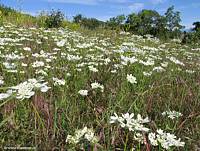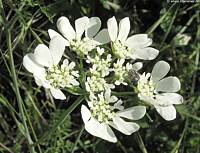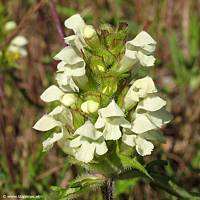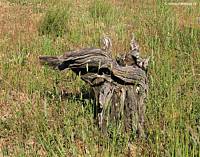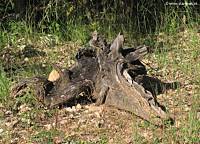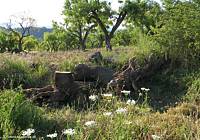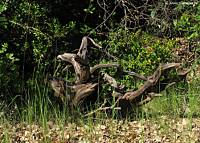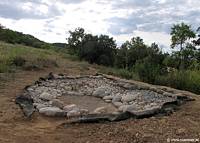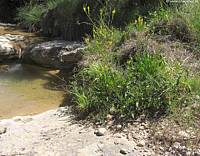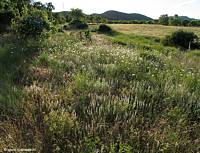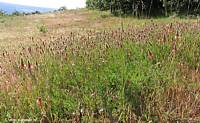|
|
Nature
Switched On
|
|
|
introduction |
2007 June 2 & 3, from Saturday to Monday 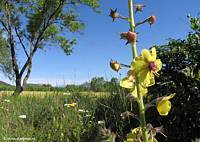 Every
weekend new species can be welcomed, some of them as a complete
surprise like these two this weekend: Verbascum
blattaria (Moth Mullein) and Anacamptis
pyramidalis (Pyramidal Orchid). Of the first, I detected 2
specimen so far but it seems to be a flower that produces a lot of
seed which germinate easily and perhaps we can look forward to a
nice field of Every
weekend new species can be welcomed, some of them as a complete
surprise like these two this weekend: Verbascum
blattaria (Moth Mullein) and Anacamptis
pyramidalis (Pyramidal Orchid). Of the first, I detected 2
specimen so far but it seems to be a flower that produces a lot of
seed which germinate easily and perhaps we can look forward to a
nice field of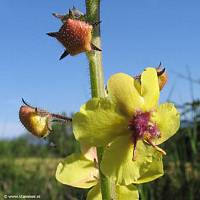 these torches in the near future. The Pyramidal Orchid is the sixth
orchid species on the terrain and is present
with 11 specimen in an sunny area of 25 m2. This Orchid is on the
Red List in countries like the
Netherlands but it seems to be expanding its territory in Europe
probably partly because of a warmer climate.
these torches in the near future. The Pyramidal Orchid is the sixth
orchid species on the terrain and is present
with 11 specimen in an sunny area of 25 m2. This Orchid is on the
Red List in countries like the
Netherlands but it seems to be expanding its territory in Europe
probably partly because of a warmer climate.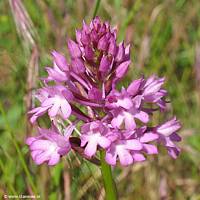 |
Moth Mullein on the lower central terrace, looking northwest. Saturday 9:45 |
|
Pyramidal Orchid on the middle central terrace. |
||
|
A new member of the floristic catalogue, which had been present with
its striking flowers for some weeks but couldn't been determined
because of the absence of the necessary fruits (compare
12 May 2007), was this
beautiful
Another species that finally could be determined was Prunella
laciniata (Cut-leaf Self-heal) showing now it's white
beehives. Like the anterior Pyramidal Orchid this Self-heal is a
characteristic species of Festuco-Brometea
grasslands on dry limestone soils.
|
||
| Orlaya grandiflora, photograph taken on 12 May 2007 9:25 |
Orlaya
grandiflora
with Melilotus altissimus, Bromus diandrus, and
Rosa canina on the middle eastern terrace. |
|
|
Cut-leaf
Self-heal. Saturday 9:23 |
||
|
Following strictly the ideas of Louis Le Roy (see
introduction) these beautiful grasslands
would develop over the years into a climax woodland. If this
woodland is really ecologically richer or desirable is a polemic
discussion but fact is that we prefer a more open area to live in
and walk through so we won't let the grassland completely turn into
a wood. This
|
||
|
|
||
|
Olive tree trunk. |
||
|
Almond tree trunks. Sunday 7:59 |
Olive tree trunk. |
|
Olive tree trunk. Saturday 9:09 |
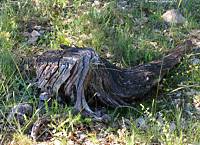 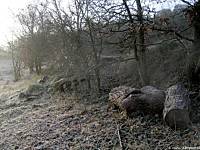 |
|
|
|
||
|
The pond from the southeast. Sunday 18:53 |
Work on the pond and the surrounding
This weekend we went for refreshment to a neighbouring valley with a small stream at 15 km from the terrain. I was surprised to find that the vast majority of species in an area within 3 meters of the river are also present on our terrain. So either the absence of a river or the presence of a pond won't probably make a big difference for the vegetation on the terrain and much bigger must be the effect on the fauna. |
|
|
A riverbank 15 km from the terrain.
In the area of the photograph I counted 15 species that were also
present on our terrain. |
||
|
Onobrychis viciifolia on the higher central terrace. Saturday 9:03 |
Little by little the colours of the vegetation are getting mixed by yellow and brown. But after wave after wave of different dominant flowers there are still some important flowers that are not flowering yet and preparing what must be a final summer festval: Daucus carota, Verbascum sinuatum, Senecio jacobaea , Chondrilla juncea , Althaea cannabina ..
|
|
|
introduction
|
|
